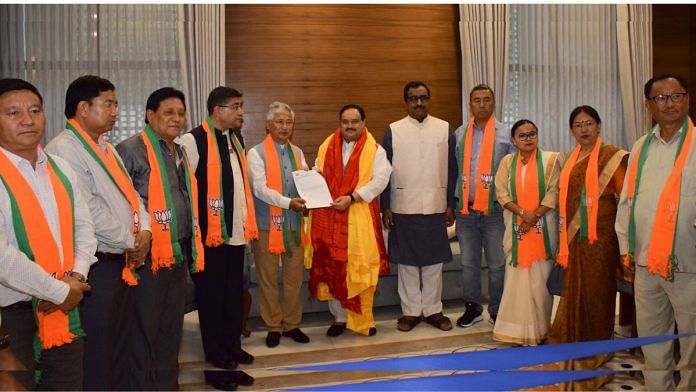The Bharatiya Janata Party’s meteoric rise in Sikkim, once considered a regional politics bastion, has shaken the state’s political landscape. The party ended its alliance with the ruling Sikkim Krantikari Morcha and announced plans to contest the Lok Sabha and assembly elections alone. What started as a strategy to engineer defections from the former ruling Sikkim Democratic Front has turned into an ambitious bid to supplant regional forces and emerge as the new power in this Himalayan state.
In the 2019 Sikkim assembly elections, the BJP had a meagre 1.62 per cent vote share and secured zero seats. However, its fortunes took a remarkable turn when 10 SDF MLAs defected to the BJP, led by Dorjee Tshering Lepcha. Coupled with victories in two by-polls, this deft manoeuvre catapulted the BJP from being unrepresented to becoming the second-largest party in the state assembly with 12 seats. Lepcha’s appointment as the state’s sole Rajya Sabha MP earlier this year provided the party a direct channel to influence Sikkim’s interests at the national level, diminishing the erstwhile exclusive hold of regional parties.
Treading a fine line
The BJP faces an uphill battle in making political inroads into Sikkim, a state firmly entrenched in regional political dominance since its merger with India in 1975. This entrenchment stems from the indigenous population’s deep-rooted trust in regional forces and fears of losing their distinct identity and constitutional safeguards enshrined in Article 371F. The extended tenures of regional stalwarts like NB Bhandari and Pawan Chamling underscore the firm roots of regional outfits, and the BJP’s unsuccessful alliances with parties such as the SKM highlight the transient nature of non-regional political involvement.
Moreover, the BJP’s acrimonious split from the SKM over apprehensions of diluting Article 371F has reignited heated discourse on safeguarding the state’s special status. While the BJP touts measures like granting tribal status and opposing RBI oversight as proof of its commitment, its unilateral abrogation of the similar Article 370 in Jammu and Kashmir has sparked widespread scepticism among the Sikkimese populace. Concerns abound that the BJP may prioritise its nationalist agenda over respecting Sikkim’s unique constitutional protections.
Compounding this challenge is Sikkim’s delicate geopolitical positioning between China, Nepal, and Bhutan. As the BJP seeks influence in the state, it must tread a fine line—uphold India’s interests, while avoiding provocations that risk regional instability. The party’s governance in frontier regions like Arunachal Pradesh and Ladakh has exposed China’s deployment of Tibetan troops along the LAC following the 2020 standoff, signalling Beijing’s territorial ambitions. To make inroads, the BJP must project calibrated strength to guard territorial integrity while preserving diplomatic manoeuvrability—a failure risks emboldening China’s revisionism and undermining its frontier position. Navigating Sikkim’s geopolitical complexities will be critical for the BJP.
Strategic manourvering
Sikkim’s rich political history underscores the state’s dynamic fabric and the people’s willingness to embrace new political forces—an opportunity the BJP can seize. Power tussles and the emergence of fresh outfits have long been woven into Sikkim’s narrative. The ruling SKM itself burst onto the scene in 2014 before forming the government in 2019. Chamling’s SDF had a comparable genesis, born out of a revolt against Bhandari in 1990 before taking charge in 1994. This context highlights the Sikkimese electorate’s openness to new forces that safeguard the state’s identity and interests.
The BJP’s Sikkim ambitions require deftly projecting positive change, while navigating autonomy concerns. Though the SDF initially converged with BJP’s NEDA (North-East Democratic Alliance) in 2016, the national party undermining allies later raised doubts over their commitment to upholding the federal spirit. This increased the risk for SDF, of this alliance backfiring in Sikkim. Correcting this heavy-handed approach is pivotal for the BJP to capitalise on the state’s political churn.
Defections have emerged as a potent BJP strategy in the Northeast, enabling governments in Arunachal and Manipur sans majorities. In Sikkim, the party grew through defections, and is now just five MLAs away from a majority. This growth, with SKM’s Rajya Sabha support, raises a possibility—orchestrated defections respecting Sikkim’s fabric could make a BJP-led government a reality. With only a slim margin needed, strategic manoeuvring is expected.
Crucially, gaining the Sikkimese people’s trust will hinge on whether the BJP can project itself as a vehicle for positive transformation rather than centralised dominance. Striking the right balance between national priorities and safeguarding Sikkim’s autonomy will be vital. As Sikkim stands at this pivotal juncture, an opportunity beckons for the BJP to usher in an era of inclusive progress that marries New Delhi’s might with regional empowerment. If it can effectively deliver on tackling unemployment, corruption and driving development while respecting the state’s distinct identity, the BJP could find traction among a disgruntled electorate.
However, any perceived undermining of Sikkim’s cherished autonomy could jeopardise this prospect and fuel resentment against the BJP’s national ambitions.
(Edited by Theres Sudeep)



